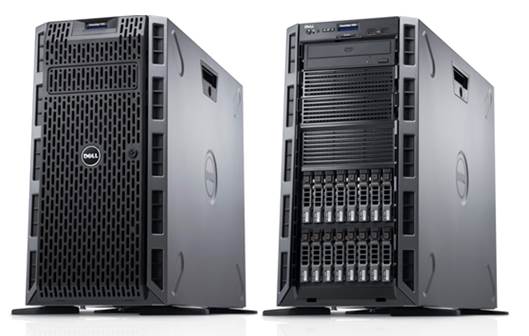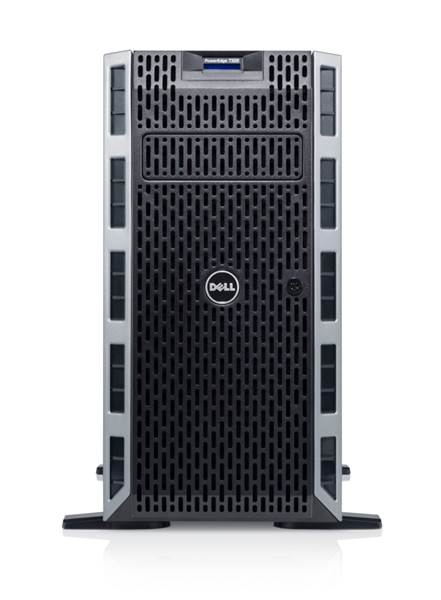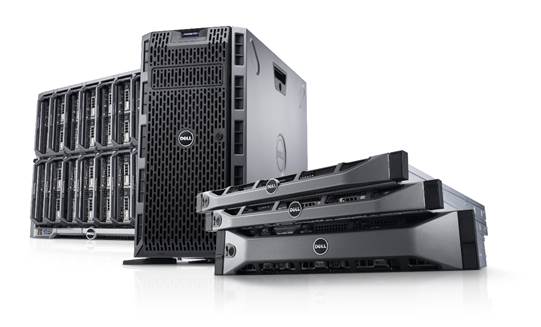A single socket server with Xeon
E5-2400 power, room to grow and very low noise levels. The PowerEdge T320 is a
top choice for SMBs
Single-socket Xeon E5 . systems are an
ideal upgrade ' for small businesses that need a new server, but there aren’t
many to choose from. Now, Dell adds another to the list with its PowerEdge
T320, which is designed to provide SMBs with a good-value workhorse capable of
running a wide range of applications. Prices start at $798 for a model equipped
with a basic 2.6GHz Pentium 1403 CPU, and you can upgrade to a 2.8GHz Xeon
E5-1410 for around $320, or choose from a small selection of E5-2400 CPUs.

Dell
PowerEdge T320
Our review system housed the slowest
E5-2400 CPU in the family, the 1.8GHz Xeon E5-2403. It has four cores, a 10MB
L3 cache and a 6.4GT/sec QPI, but memory speeds are limited to 1,066MHz, and
neither Hyper-Threading nor Turbo Boost are supported.
The Xeon E5-2403 has a low TDP of 80W,
which helped the Dell perform well in our power tests. With Windows Server 2012
idling, the review system drew a modest 68W from the mains. Under heavy load
from the SiSoft Sandra benchmarking app, that figure rose to only 81W.
Our system included the basic 350W cabled
PSU, but it’s possible to upgrade the system with dual PSUs for power
redundancy. Dell offers dual 475W and 750W hot plug PSUs as a configurable
option during the order process.
The PowerEdge is likely to be a hit with
small offices that demand tranquility: cooling is handled by a single 120mm fan
at the rear that barely makes a sound. The T320 is also capable of surviving
life in warmer offices, as it supports Dell’s Fresh Air initiative: this means
it’s rated to operate safely in ambient temperatures of up to 40°C for 900
hours a year, and in temperatures of 45°C for 90 hours in the same period.
The T320 has oodles of storage potential.
Our review system was fitted with the basic four-bay cold-swap cage, filled
with a quartet of 500GB Enterprise SATA hard disks, and each drive was cabled
directly to the motherboard’s 3 Gbits/sec SATA port and managed by the embedded
PERC SI 10 RAID controller.

Our
system included the basic 350W cabled PSU, but it’s possible to upgrade the
system with dual PSUs for power redundancy
Those who need more storage aren’t short of
options. It’s possible to upgrade to a front-loading eight-bay hot-swap LFF
cage, although it’s worth bearing in mind that you’ll need to shell out for a
PERC PCI Express RAID card if you want to use all eight bays. Businesses with a
hunger for storage can also order the T320 with a 16-bay SFF hot-swap cage.
The optional SFF cage supports SAS or SATA
drives, and you can choose from pedestal-or rack-mount chassis configurations.
If decent remote management is high up on
your shortlist, it’s definitely worth upgrading from Dell’s Basic Management
option. The savings are tempting, but all you get is shared access to the first
network port, and remote power controls via Dell’s IPMISH command line utility;
it’s far better to cough up the extra $184 for the iDRAC7 card.
The iDRAC7 Express version provides remote
web browser access and server monitoring, and shelling out a further $268 on
the Enterprise upgrade (as found in our review system) enables full remote
control and virtual media services.
Usefully, you can start with the Express
card and upgrade later on: the dedicated network port and vFlash slot are
already present on the Express card and can be enabled by entering a license
key. Both versions of the iDRAC7 interface allow you to monitor the Dell’s
Fresh Air operating temperature thresholds, albeit only on systems that have
dual redundant PSUs.
Along with dual embedded Gigabit ports,
there’s plenty of room for further expansion: the motherboard provides five PCI
Express slots. Dell offers upgrades to Nvidia Quadro 4000 or 6000 graphics
cards for businesses planning on running apps such as medical imaging,
rendering or desktop virtualization.

It
delivers E5-2400 power at a reasonable price, has plenty of room to expand, and
its low noise levels and solid build quality make it suited to life in a small
office
The T320 also makes for a great
virtualization platform. Dell’s dual SD card controller -which provides
automatic hypervisor redundancy by mirroring the contents of the primary boot
card to the secondary card - remains unique to the PowerEdge range. Dell’s
PowerEdge T320 has little in the way of rivals - neither HP nor IBM has
anything in their portfolios to match it, and Lenovo offers only two Xeon E3
towers. Small businesses that need a new server, but don’t want the expense of
dual sockets, will find the T320 fits the bill nicely.
It delivers E5-2400 power at a reasonable
price, has plenty of room to expand, and its low noise levels and solid build
quality make it suited to life in a small office.
|
Key Specs
·
Pedestal chassis with four internal cold-swap
3.5in drive bays
·
1.8GHz Xeon E5-2403
·
12GB DDR3 RDIMM (max 192GB)
·
Dell PERC SI 10 embedded SATA controller
·
supports RAIDO, 1, 5,10
·
4x 500GB Dell Enterprise SATA hard disks
·
5 x PCI-E 3 slots
·
2 x Gigabit Ethernet
·
350W fixed PSU
·
Dell iDRAC7 Enterprise
·
3yr on-site NBD after remote diagnostics
warranty
·
Power: 68W idle; 81W peak
|